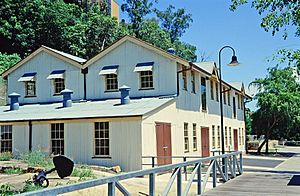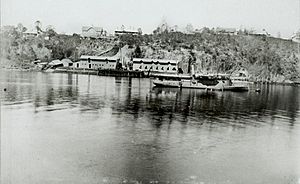Naval Stores, Kangaroo Point facts for kids
Quick facts for kids Naval Stores, Kangaroo Point |
|
|---|---|

Naval Stores, Kangaroo Point
|
|
| Location | 34 Amesbury Street, Kangaroo Point, Queensland, Australia |
| Design period | 1870s - 1890s (late 19th century) |
| Built | 1886 - 1900s |
| Official name: Naval Stores (former), Naval Brigade Stores, Naval Depot | |
| Type | state heritage (archaeological, built) |
| Designated | 21 October 1992 |
| Reference no. | 600239 |
| Significant period | 1880s-1900s (fabric) 1880s-1950s (historical) |
| Significant components | slab/s - concrete, store/s / storeroom / storehouse, hut/shack, toilet block/earth closet/water closet, turntable, changing rooms/dressing shed, magazine / explosives store, wharf/dock/quay, slipway, steps/stairway, paint/chemical store |
| Lua error in Module:Location_map at line 420: attempt to index field 'wikibase' (a nil value). | |
The Naval Stores is a special old building located at 34 Amesbury Street in Kangaroo Point, Queensland, Australia. It was built between 1886 and the early 1900s. This building is also known as the Naval Brigade Stores or Naval Depot. It was added to the Queensland Heritage Register on October 21, 1992, which means it's an important historical site.
Today, an adventure company called Riverlife Adventure Centre uses the Naval Stores building. They offer fun activities like kayaking and rock climbing.
Contents
The original Naval Stores complex had two main buildings. They were two stories tall and made of iron and wood. There was also a wharf (a dock for boats). These buildings were put up between 1886 and 1888.
For many years, the complex was used by both the navy and the army. It served two main purposes: storing important items and training naval officers and soldiers.
In 1884, people in Queensland were worried about a possible war with Russia. Because of this, the Queensland government ordered two special warships called gunboats. Their names were the Gayundah and Paluma.
When these gunboats arrived in 1885, the government realized they needed a place. They needed somewhere to store equipment, fix ships, and train naval staff. So, the Naval Stores were built on the site of an old quarry at Kangaroo Point. This area is now known as the Kangaroo Point Cliffs.
What Was Inside the Buildings?
The first building, called Store No 1, had training rooms on the ground floor. These rooms were used for learning about batteries and for lectures. Upstairs, there were four rooms for storage and carpentry workshops. By 1913, the upstairs area was divided into more rooms, including an office and smaller storage spaces.
Store No 2 originally had two large rooms on each floor. The ground floor had workshops. The first floor storerooms included a place to keep torpedoes, which are underwater weapons.
Changes Over Time
After the big Brisbane floods in 1893, some changes were made. The boat shed at Store No 1 was replaced with a separate shed. A bridge was built to connect the two main stores. The stairs leading up the cliff were also made longer.
Around 1900, more additions were made to the site. These included a paint store and a magazine (a place to store explosives). A special turntable was added between the stores to help move guns. Some ceilings on the first floor were also covered.
The wooden stairs at the site go up the cliff to Amesbury Street. They also lead to St Mary's Anglican Church, which has been the navy's chapel for many years. These stairs have been extended over time.
As the Queensland Naval Brigade grew, other naval depots were set up. These were in places like Maryborough, Rockhampton, Townsville, Cairns, and Cooktown. The Naval Stores in Kangaroo Point was the main base for the Queensland Navy. This was true until the Royal Australian Navy was formed after Federation (when Australia became one country).
Modern History and Current Use
An important moment in radio history happened here in 1903. The Gayundah, one of the gunboats, became the first Australian ship to use wireless telegraphy. It sent signals from Moreton Bay to the Naval Stores.
The Royal Australian Navy made more changes and built new structures while they used the site. The RAN Reserve left the site in 1959. After that, the Australian Army used the buildings until 1984.
In 1984, two large guns from the Gayundah and Paluma were found. One of these guns is now on loan to the Queensland Maritime Museum Association.
Some parts of the site, like the flagpoles and a semaphore (a signaling device), have disappeared since 1984.
In 1987, the Brisbane City Council bought the property. Sadly, a fire partly destroyed Store No 1 that same year. Store No 2, which was empty, also suffered damage from vandals and white ants.
The complex sits on a narrow flat area next to steep cliffs. Here are some of the things you can still see there:
- Store No 1 (built 1886–88): Only the ground floor and burnt parts of the first floor remain after the 1987 fire. Before the fire, it looked similar to Store No 2.
- Store No 2 (built 1886–88): This building is smaller. It has two small gables with hoists (for lifting things) and two pairs of vents. There are pairs of wooden doors. Inside and outside, wooden stairs lead to the first floor. It's made of hardwood covered with corrugated iron. The ground floor is concrete, and the roof has two gables (pointed ends). The windows have many small panes of glass and are protected by sunhoods. The walls and ceilings inside are covered with wooden boards. At one end, there's a small smithy (a blacksmith's workshop) with a sloped roof.
- Wharf (built 1887–88): This dock is an important part of the stores. Wooden poles support the wooden deck. The wharf has been re-covered with diagonal wooden boards over the original ones.
- Wooden Stairs (around 1890): These stairs connect different parts of the complex. They are currently in poor condition and not safe for people to use.
- Turntable (around 1900): This was used to turn and move guns to and from ships. Only its outline can be seen today.
- Paint Store (around 1900): This is a small, one-room wooden building on stumps. It has a hip roof (sloping on all sides) made of corrugated iron.
- Magazine (around 1900): This is a single-room building made of weatherboard (overlapping wooden planks). It has a corrugated iron gable roof and sits on brick stumps.
- Slip (around 1900): This is a concrete ramp that has been made longer over the years. It was likely used to launch or pull boats out of the water.
- Duty Hut: A small, one-room wooden building with a pyramid-shaped corrugated iron roof. The inside is lined.
- Changing Rooms: These are made of timber with a sloping corrugated iron roof. They were built on the foundations of the boat shed from the 1890s.
- Toilet Facilities: A building made of timber and corrugated iron.
The Naval Stores complex is still a very noticeable sight along the river today.
The former Naval Stores were added to the Queensland Heritage Register on October 21, 1992, because they meet several important standards:
The place shows how Queensland's history developed. The old Naval Stores help us understand the Queensland Marine Defence Force. This force was a key part of Queensland's defenses when it was a colony.
The place is beautiful to look at. The former Naval Stores are important because they are part of the historic view at Kangaroo Point. This view also includes the old Kangaroo Point quarry, the St Mary's Church buildings, and the stairs connecting them up the cliff.
The place has a special connection with a group of people. The Stores are important because they have always been linked to both the colonial (before Australia became a country) and Commonwealth (after Australia became a country) defense forces.



